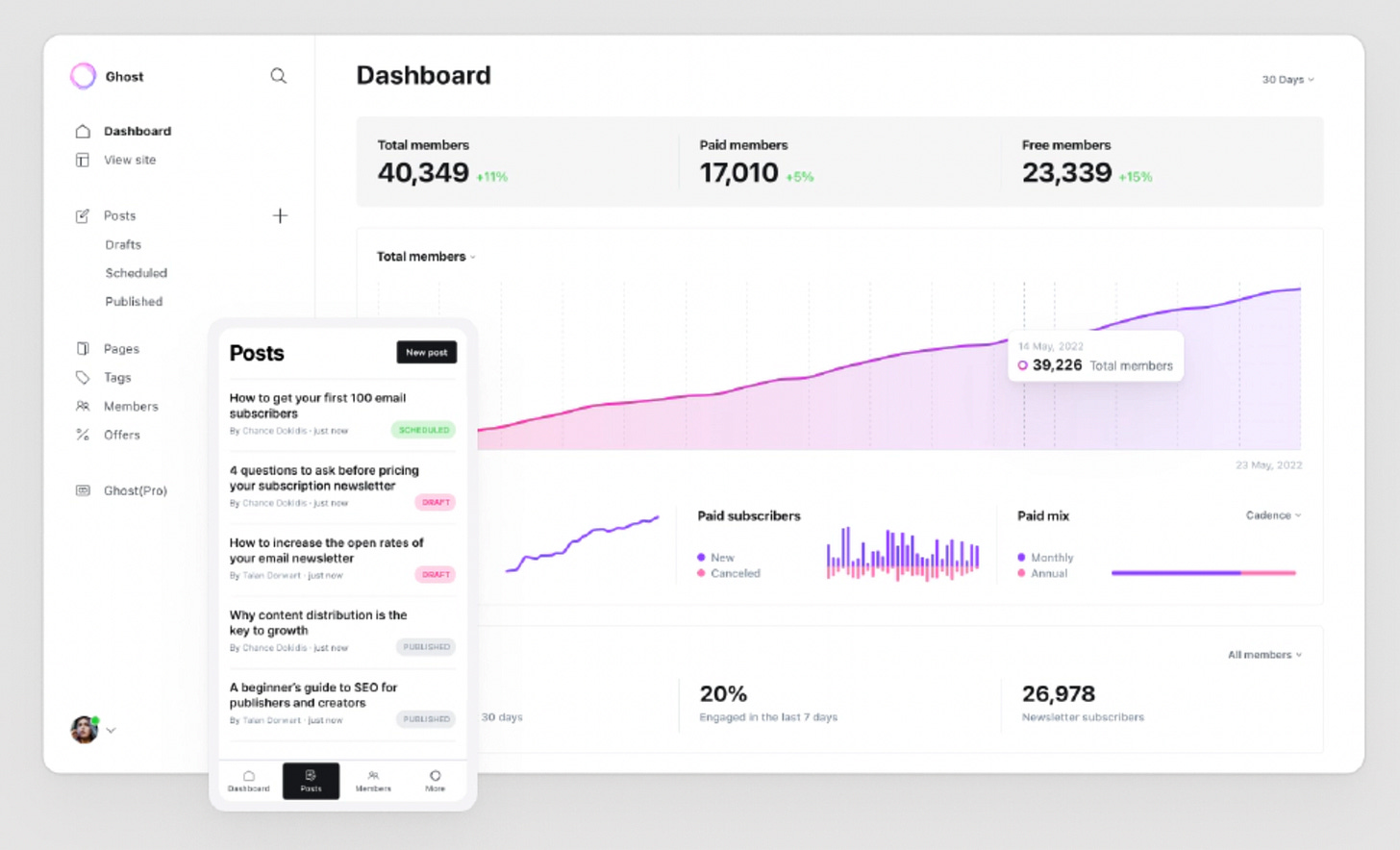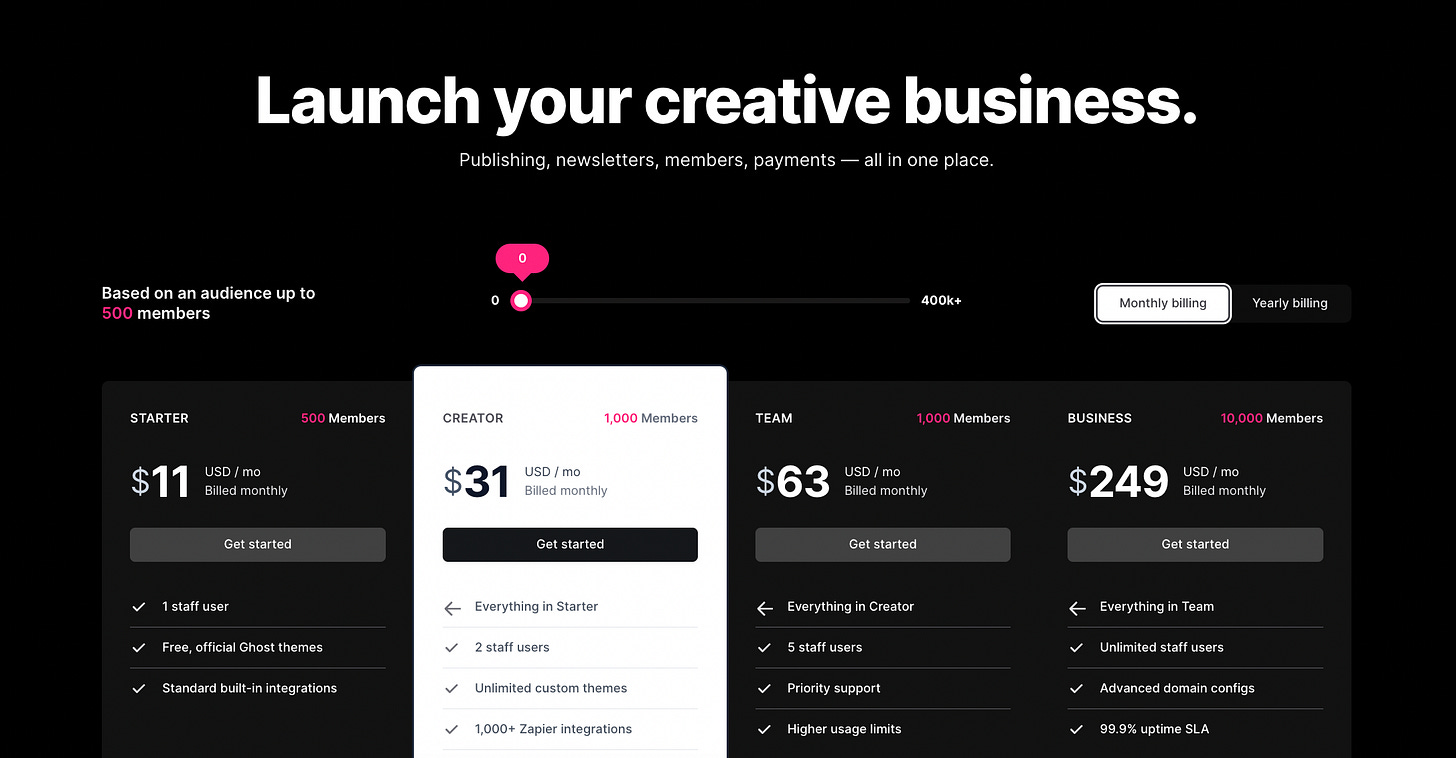Exploring Ghost: A Fresh Start in Light of Recent Headlines
Transitioning from Substack to Ghost: Unveiling Our New Publishing Suite with First-Hand Experiences and Setup Tips
Berlin marks 6 PM | New York greets 2 PM | LA embraces 11 AM
Hello again, this is Daniel. Yes, our lengthy edition just reached your inbox yesterday. After pressing the 'send' button, I caught up on the recent headlines surrounding Substack. The journalist in me couldn't ignore the urge to share my research from the past month, especially when it's so relevant to those pondering the future of their newsletters this weekend. My goal is to aid in making a well-informed decision.
I realize that a deep dive into Ghost might seem off-topic. However, since it will be the new home for our newsletter starting next week, I believe you'll find this behind-the-scenes story intriguing, even if you're not currently publishing a newsletter. While writing this issue, I was surprised to discover how closely related this topic is to threads and decentralized social media, more so than I had initially thought.
What's Inside This Issue: This wasn't initially on my long-term agenda, but while compiling this report, I realized that a virtual meet-up is also pertinent to the ongoing discussion. You'll find the invitation further down.
Ghost — From a Nerdy WordPress Alternative to a Full-Service Platform for Digital Creators
Prelude
Years ago, a friend introduced me to Ghost. He had restarted his blog and preferred a software solution that focused on the core of blogging, unlike WordPress, which had evolved from a simple blog software to a more complex homepage operating system, akin to Windows.
Back then, Ghost wasn't as straightforward to install as WordPress, which used a PHP script and a MySQL database. Since my WordPress site was running smoothly, I moved on without giving Ghost much thought.
Fast forward to a year ago when Elon Musk decided to shut down my favorite newsletter service, Revue. This Dutch startup had been acquired by Twitter not long before. Revue was beloved by journalists and bloggers like me for its focus on content rather than campaigns and marketing. It offered an excellent editor for creators and a beautiful experience for readers. After its closure, I explored various newsletter services but found them overly complex. I was accustomed to a simple workflow: log in, write as if creating a blog post, and hit send. With most services, creating a newsletter was more about building it from scratch. That's when Ghost reappeared on my radar. I was impressed by its development; it had transformed from a mere WordPress alternative into a specific service for digital creators who prioritize content and audience engagement and are interested in monetizing their work.
Recreating the Revue experience with Ghost was indeed possible. As a publisher, I could simply log in, write, and either publish a blog post or send a newsletter, or even do both. Ghost even offered a Revue-oriented theme. Beyond this focus, the developers addressed a pain point for many
content creators: the ease of publishing was generally limited to platforms that became increasingly restrictive. Platforms like Patreon expanded to include publishing options for text, audio, and video alongside their membership handling. Steady added newsletters, and website services like Webflow or Squarespace ventured into the membership business. Substack, known for its newsletters, incorporated memberships, podcasts, and various social and recommendation features into its universe.
Bloggers and podcasters, accustomed to a decentralized structure with control over their web space, media files, RSS feeds, and user lists, were reluctant to trade this freedom for a nearly perfect publishing process in a platform environment. Ghost recognized this need, maintaining its focus while creating a Substack-like experience that runs independently on chosen web space. They even developed themes reminiscent of other platforms and found a way to emulate successful recommendation systems without being a platform themselves, allowing for cross-website functionality.
However, installing the open-source software requires features not typically available on regular web spaces used by bloggers, as well as a deeper technical understanding compared to setting up WordPress. An alternative is using a hosted version of Ghost, but the monthly fee, compared to the free account models with revenue sharing offered by Substack, Patreon, and others, can be a deterrent.
This week, in light of recent headline-making events around Substack, we've seen creators place a higher value on independence, even if it means investing more effort or money. To assist in this decision, let's explore how Ghost functions today for those considering it as their platform of choice.
Introduction to today’s Ghost
Ghost is renowned as a platform for professional publishing, well-known for its blogging and content management system (CMS). As an open-source software, it's tailored for modern journalism and content creators. Let's delve into the key features of Ghost:
Content Management: Ghost boasts an intuitive editor and CMS focused on efficient content writing and structuring, emphasizing simplicity in publishing.
Customization and Design: The platform offers customizable themes and integrations, with a variety of modern, responsive designs suitable for different content types.
SEO and Social Media Integration: Ghost includes built-in SEO tools and social media integration, enhancing content visibility and shareability.
Membership and Subscriptions: A standout feature of Ghost is its native support for memberships and subscriptions, enabling creators to monetize content through paid subscriptions.
Open Source: As open-source software, Ghost allows for extensive modification and customization by developers.
Performance and Security: The platform prioritizes fast and secure publishing for its users.
Hosting Options: Ghost provides options for self-hosting or using Ghost's hosting service, which includes automatic updates and backups.
Ghost in a Nutshell:
Ghost is popular among bloggers, journalists, and content creators seeking a more focused and streamlined platform compared to other CMS options like WordPress.
Its emphasis on content and simplicity, combined with powerful features for monetization and audience engagement, makes it a preferred choice for independent publishers and media organizations.
The Frontend
With Ghost, you can run your personal page, showcasing your portfolio, services, or operate it as a blog, podcast, or newsletter page. You have the flexibility to make your content accessible to all, registered users, or paying subscribers, with options like landing pages or segmented mailings. Ghost also supports community building.
The platform's themes are aesthetically pleasing, with a plethora of free and paid options in the Marketplace. These themes are highly customizable, allowing extensive personalization without coding. However, you always have the option to download, modify the code, and re-upload your customized version.
The Backend
Ghost's editor is user-friendly, accommodating a variety of modules like pictures, galleries, social embeds, call-to-actions, and quotes. This versatility is beneficial whether you're creating an event listing, a regular blog post, a complete newsletter issue, or even static pages. Ghost distinguishes between pages and posts and allows the use of public and internal tags to organize content and control its display. Every post can be published, sent as a newsletter, or both.
The backend dashboard presents current audience and engagement data, with settings that are straightforward to understand and modify. You can tailor your audience strategy to focus on newsletters, lead generation, or exclusive content for registered or paying members. If you activate memberships, you can define tiers, set prices, and outline benefits. Front-end users can access specific content, manage their newsletter subscriptions, or upgrade to a paid membership through an intuitive self-service interface. Ghost uses a magic-link login system for simplicity, though customization options for login, subscribe, and membership modules are limited. Membership payments are processed through Stripe.
While Ghost does not offer a plugin system like WordPress, it allows easy integration with other services through webhooks and a powerful API. Additional features can be added to your site using code injection.
Ghost provides valuable content on using the platform, building an audience, and managing workflows beyond content creation. Almost every Sunday, a new newsletter issue is released, featuring tutorials, guest author articles, and new feature introductions. Ghost is in a phase of frequently delivering useful new features and improvements.
Ghost vs. Other Platforms
Ghost & Substack: Ghost offers all the familiar features of Substack, except for Notes and the Substack app. Ghost's independent recommendation system works across the web without being a platform. Regarding membership revenue, Ghost users only pay Stripe's transaction fees, avoiding additional platform fees like Substack's 10%.
Ghost & Beehive: Beehive, with its strong newsletter editor, focuses more on lead growth and monetization. Its web page options are less flexible, and the pricing starts higher compared to Ghost. Beehive's model is more suitable for those with large subscriber lists.
Ghost & Patreon: Patreon's advantage lies in its existing user familiarity. However, considering the fees and publishing features, Ghost offers more independence and is more attractive financially.
Ghost & Steady: Steady excels in smooth user onboarding for memberships, handling all payment processes. The 10% fee may seem reasonable for the convenience, but with Ghost's comparable solutions and more extensive publishing options, Ghost comes out ahead. When leaving Steady, subscribers must re-subscribe, whereas Ghost provides more control over subscriber lists.
Ghost & WordPress + Newsletter Service: While WordPress can offer similar features for free, it requires multiple plugins, which can be less efficient and more complex than Ghost's integrated approach.
Self-Hosted vs. Hosted Version:
Hosted Version: The ease of signing up for Ghost's hosted version is appealing, but it comes at a cost. To utilize all features, the monthly fee starts at 31 US Dollars. If your subscriber list exceeds 1000 names, the price increases to 50 US Dollars monthly, covering up to 3000 audience members. This cost consideration, along with the potential impact of Substack's recommendation system on subscriber growth, influenced my decision to initially start with Substack. In the early stages, attracting at least one subscriber per month to a paid annual subscription is necessary to offset costs. Financially, this approach may become more advantageous over time, but the success of such an investment is uncertain when starting a new project.
Self-Hosted: Although Ghost is open-source, there are associated costs to consider. Web hosting options start at around 6 Dollars monthly, but given Ghost's resource demands, a more realistic budget is likely around 20 Dollars monthly for a fast and reliable service with backups. Installation services by freelancers are available for approximately 100 Dollars, but regular updates are crucial, potentially requiring familiarity with SSH terminals and Unix systems, or an ongoing arrangement with a freelancer.
Another consideration is the cost of sending newsletters. The hosted version includes this expense, but for self-hosting, a separate solution is needed. Unfortunately, the specific partner for newsletter dispatch, which once offered a free plan for Ghost users, has discontinued this option. The starting cost for GDPR-compliant email sending is about 30 US Dollars monthly. While it's possible to integrate other mail providers through APIs and webhooks, this adds complexity to the setup, publishing process, and increases the risk of failure, as evidenced by discussions in Ghost's official forum (a valuable resource in itself). Despite managing to set up Ghost independently, the monthly email fees and the need for workarounds made this option less attractive for me, leading to my decision to opt for the hosted version.
Multiple Projects Consideration: It's important to note that while you can run several newsletters on Ghost, it doesn't support multiple different websites on the same instance. For managing separate projects like a personal page, a media podcast, or other potential ventures, each would require its own Ghost instance. This could significantly increase the monthly budget for digital services, which may not be feasible or reasonable at the moment.
Transition to Ghost: Despite these considerations, I am pleased to move my promising Substack newsletter to Ghost. The platform's features and independence align with my goals and vision for the newsletter.
Ready for the Fediverse
The open structure of Ghost not only fits well with the ethos of decentralized social media but also offers exciting possibilities. I am working on a concept to integrate a Ghost publication with the Fediverse, allowing for interactions across various platforms. This could mean Mastodon users commenting on your blog or Thread users reading your newsletter, and even receiving a personalized feed from Fediverse accounts you follow. I aim to implement this in the coming months and plan to share this breakthrough with everyone supporting this newsletter through a paid subscription.
This integration represents a significant step forward in content creation and monetization in decentralized social media, offering control over follower relationships and reducing dependency on centralized platforms. As a journalist passionate about audience engagement and digital formats, this development excites me.
Want to See Ghost in Action?
For a practical demonstration, I've recorded a how-to video showing the setup of Ghost for this newsletter, including the process of importing content from Substack. Additionally, I've prepared a presentation with specific examples and personal experiences regarding Ghost. If you're interested, see the following invitation;
For our German speaking friends:
Einladung zum Ghost Meet-up für Digital Creator - von Style & Stitches und Was mit Medien.
Wann? Montag,15. Januar um 16 Uhr oder Montag, 22. Januar um 18 Uhr.
Was?
Input von Daniel Fiene wie die Migration von Substack zu Ghost funktioniert und wie sich Ghost von anderen Plattformen wie Steady, Beehive, Patreon, ConvertKit oder Brevo unterscheidet.
Gemeinsamer Austausch über Ghost und andere Plattformen für die eigenen digitalen Projekte.
Wo? Via Zoom.
Wie?
Tickets gibt es kostenlos, wenn ihr live via Zoom dabei sein möchtet.
Mit eurer Paid-Subscription von Style & Stitches, eurem Membership von Was mit Medien oder für 10 Euro erhaltet ihr ein Ticket-Plus. Das beinhaltet eine Dokumentation als PDF, ein Video zum Nachgucken für vier Wochen und ein zusätzliches Erklär-Video mit den ersten Schritten auf Ghost, inklusive Umzug eines bestehendes Projekts.
Community Knitting: 100 Things To Do on Threads
While it's possible to gauge the impact of Substack headlines through changes in subscriber rates, I'd like to focus on something more uplifting. Thanks to our growing community, our subscription counter has jumped up by two, now proudly displaying 106 subscribers. To celebrate, let's divert our attention from platforms and strategies for a moment and indulge in some fun and inspiration for our feeds. Here are two more entries from our "100 Things To Do on Threads" list:
#5 Follow @Pubity on Threads. This account offers a mix of news and entertainment content, from historical anecdotes to heartwarming stories, consumed by more then 4.5 million followers.
#6 Follow @techemails on Threads: This account shares interesting tech industry emails that have become public.
Coming Up
As we began this week, I hadn't anticipated delving into an in-depth exploration of Ghost, nor did I expect to be managing the migration of this newsletter to a new service. This came amidst the recent completion of our fresh start and the following launch of paid subscriptions just last week. But please don't misunderstand; this isn't a complaint.
The bulk of the work is now behind us, and the exciting opportunities that lie ahead, coupled with the prospect of interacting with many of you at our upcoming (and very impromptu) first meet-up in two days, are indeed positive developments.
With this transition, we will also return to the regular programming of this newsletter. However, the next edition will be sent out via Ghost. This change will allow me to refocus on our January funding goal, where we are just four annual paid subscriptions away from enabling further development of this newsletter.
Stitch On,
Daniel
P.S.: Have you registered for your free ticket to our live meet-up yet?
Craftingterm of the Day: In the world of knitting and crochet, "blocking" is a finishing technique used to shape and set your completed project. After all the stitches are in place, blocking involves wetting or steaming the fabric and then allowing it to dry in the desired shape. This process helps even out stitches, align edges, and can dramatically enhance the appearance of lace or intricate patterns. Whether you're a seasoned crafter or a beginner, mastering the art of blocking can take your projects from homemade to handcrafted with a professional touch.
The concept of "blocking" in crafting symbolically parallels the theme of transformation and refinement as we see it these days in the newsletter scene. Just as blocking transforms a knitted or crocheted piece into its final, polished form, we’re discussing transitioning our digital projects to a new platform and the improvements and opportunities this change brings.
From Europe with <3









